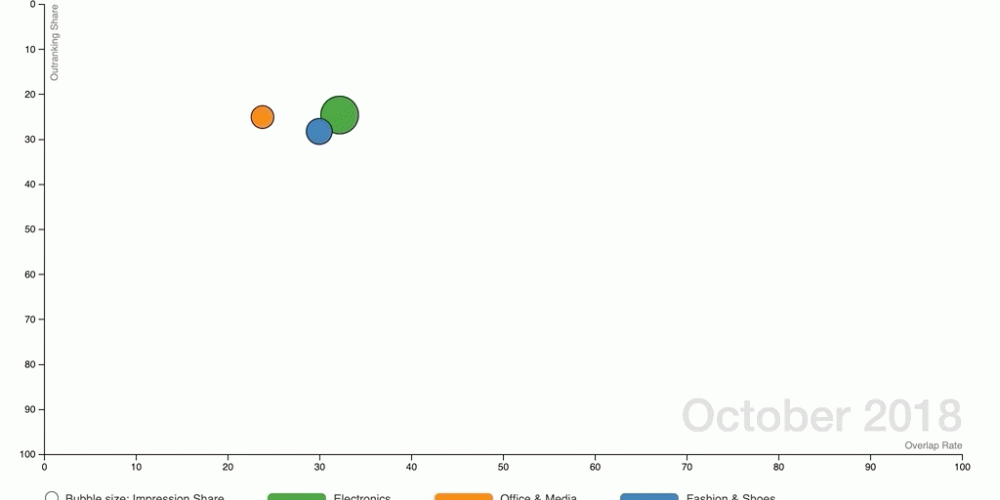Subscribe to join thousands of other ecommerce experts

What should merchants expect from Amazon during the holidays in their Google Shopping auctions? Continued dominance. Beginning in November 2018, Amazon aggressively activated their inventory in Shopping ads across multiple industries – with no signs of slowing down. Brands and retailers looking to maximize their holiday sales volume this year should expect sustained investment from Amazon. The shadow of this market-shaking giant is manifested in terms of three core metrics from the Auction Insights tab in Google Ads:
- Outranking share: Merchants can expect to see a low outranking share against Amazon, meaning that Amazon is grabbing top-converting slots in Shopping section of the SERP.
- Overlap rate: It’s bad enough if Amazon outranks you in an auction, but the data shows that this colossus will likely be present in a lot of your auctions – potentially a majority.
- Average impression share: This metric demonstrates the percentage of an advertiser’s eligible items that are actually being served. We don’t know in absolute terms how many items Amazon puts in their Shopping feed, but they’re very successful at promoting these items, which is a driver of overlap rate.
We’ve gathered auction insights data from 75 top merchants in 3 key industries from January 2018 through October 2019 to help expose Amazon’s activities in Google Shopping. We then built an animated chart that combines the metrics above to form a sort of “power bubble” with which we can track Amazon’s competitive strength over time.
It looks like this:
When the bubble moves up, it indicates an increase in outranking power. For example, an outranking share of 10 indicates that merchants in a given industry are only outranking Amazon 10% of the time. When the bubble moves to the right, it means that Amazon is increasing their overlap rate in the given industry. Meanwhile, when the bubble grows in diameter, this suggests that Amazon has become more effective at advertising their product feed – or alternately, that they’ve reduced their feed to focus on top sellers. However, the general trend of an increasing overlap rate suggests that Amazon is not reducing their feed size.
While 25 merchants per industry is not a huge sample size, I have to stress that qualitatively these merchants are outstanding – they have large budgets as well as highly optimized Shopping campaigns, and are therefore situated as robust competitors in the auction environment. It is only more striking to see how even top merchants are outgunned by Amazon.
So then: how is Amazon achieving this result in Google Shopping, what is their strategy, and what can you do about it?
It’s quite simple how Amazon gets results like this – they spend like hell, with a (seeming) disregard of efficiency. Most merchants keep a close eye on ROAS, CPA, and other KPIs in order to achieve a reasonable and profitable level of competitiveness. The math looks different for Amazon, and “reasonable” is simply not in Amazon’s DNA. It’s quite evident that they are intentionally placing very high, aggressive Shopping CPCs in a manner which the rest of the market would find unsustainable.
Of course, Amazon has the cash flow to cover an investment like this, but it’s also highly strategic of them. They are presumably not optimizing for AOV (individual basket values), but rather CLV – customer lifetime. Their Prime membership and strong value propositions around delivery are powerful weapons for catching Google product searches via Shopping ads and converting those individual searchers into loyal Amazon customers with a solid annual revenue per user. Plus, by dominating Shopping they are using one of Google’s top revenue drivers as a trojan horse for their brand to grab market share. It’s pure Bezos.
In regards to the last question – “what can you do about it?” – I don’t have a silver bullet to offer you. I would recommend digging into your topseller overlap with Amazon, assessing your margins, really challenging your pricing, and then deciding which battles you want to fight. Plain and simple, Amazon is going to be present in a strong position in many of your auctions, and it could kill you to try and outbid them.
But when all is said and done, Amazon is applying a brute force strategy. By being focused and targeted, you can act like a guerrilla force to minimize harm and maximize wins:
- Use a product-specific structure to facilitate targeting and strategic agility
- Use query-level strategies to bid high on the right users (higher conversion rates and higher average order values)
- Use margin data to push profitable products that can survive competitive CPCs, acting as door openers
- Back it up with a friction-free checkout, relevant on-site product recommendations, plus memorable branding
Special thanks go to Miriam Torres for collecting this data, Tim Wlcek for data wrangling and data pipeline, and Ivan Petrov for the data visualization.

